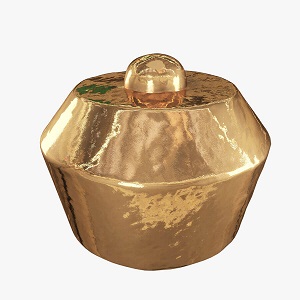Kenong
 The kenong is a metal gong idiophone of the Javanese people of Java, Indonesia. It is a punctuating instrument that is part of the Javanese gamelan (the iron gamelan to which the instrument pictured on this page belongs has eleven kenong jaler (see detail image). ‘Jaler’ means ‘male,’ so the Javanese use a gender maker to distinguish between the physical form of the kenong described here and that of a second basic form of horizontal-resting gongs, called ‘setrèn’ (‘female’), with a shallower recep and broader rai.
The kenong is a metal gong idiophone of the Javanese people of Java, Indonesia. It is a punctuating instrument that is part of the Javanese gamelan (the iron gamelan to which the instrument pictured on this page belongs has eleven kenong jaler (see detail image). ‘Jaler’ means ‘male,’ so the Javanese use a gender maker to distinguish between the physical form of the kenong described here and that of a second basic form of horizontal-resting gongs, called ‘setrèn’ (‘female’), with a shallower recep and broader rai.
Although Javanese forged bronze gongs in general are remarkable products of highly skilled and admired craftsmen (see goöng), gongs made from iron are not accorded the same level of admiration. Nonetheless, it takes a team of specialized craftsmen to construct iron gongs such as the kenong pictured and described here, and when well constructed they can produce a musically satisfying alternative to their far more costly counterparts in bronze gamelans.
The term ‘kenong jaler’ (here simplified to ‘kenong’) refers both to a single gong of the type described below (see gallery image) or collectively to all the gongs of this type found in a single gamelan (see detail image). The kenong described here is part of an iron gamelan and therefore the details of the physical description to follow differ from those of the same instrument found in bronze gamelans (see kenong (Sundanese)). Each kenong is constructed from three interlocking pieces of sheet iron, one circular and the other two elongated rectangular strips. The strips are connected end-to-end with rivets to form the gong's circular side/rim (bau), which in turn is attached to the edge of the circular face by folding (accomplished with much cold hammering) to create an integral vessel. With further hammering a central knob/boss (pencu) is articulated as well as two concentric surface areas: a flat rai around the pencu, and a sloping recep (brunjung) around the rai. Such contouring of the face is essential to achieving a gong with definite pitch. The pencu is reinforced with a brass cap that is riveted to the iron knob. All seams are soldered and then filed smooth. The gong rests horizontally on ropes running diagonally between the corners of its square wooden rack. The performer uses a wooden stick beater (tabuh) padded with tightly wound cord to strike the pencu of gong.